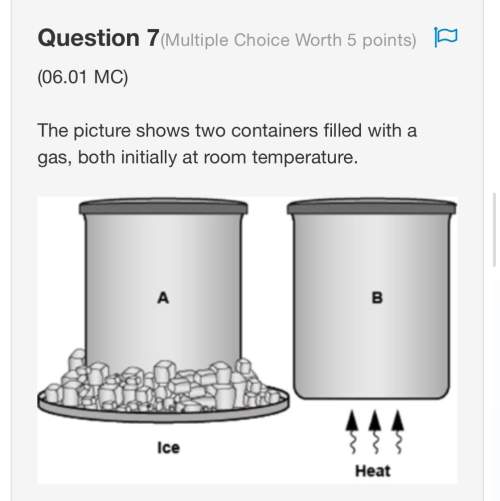Match these items with their correct definitions.
1 .
baking soda
last two...

Chemistry, 08.10.2019 10:30 milkshakegrande101
Match these items with their correct definitions.
1 .
baking soda
last two horizontal rows on the periodic table
2 .
shell
elements to the left of the “stair-steps” in the periodic table
3 .
water
elements to the right of the “stair-steps” in the periodic table
4 .
nonmetals
hold the secret to chemical change
5 .
rare earth elements
path or orbit in which electrons whirl about nucleus
6 .
electrons
a common base
7 .
metals
h 2 o

Answers: 2


Another question on Chemistry

Chemistry, 21.06.2019 17:50
Which best describes why nh4+ can form an ionic bond with cl-?
Answers: 3

Chemistry, 22.06.2019 05:00
Which position represents spring in the southern hemisphere? a) b) c) d)
Answers: 2

Chemistry, 22.06.2019 06:00
Oxidation-reduction reactions (often called "redox" for short) are reactions that involve the transfer of electrons from one species to another. oxidation states, or oxidation numbers, allow chemists to keep track of these electron transfers. in general, one element will lose electrons (oxidation), with the result that it will increase in oxidation number, and another element will gain electrons (reduction), thereby decreasing in oxidation number. the species that is oxidized is called the reducing agent or reductant. the species that is reduced is called the oxidizing agent or oxidant. to sum up: oxidation = increase in oxidation state = loss of electrons = reducing agent reduction = decrease in oxidation state = gain of electrons = oxidizing agent part a which element is oxidized in this reaction? fe2o3+3co→2fe+3co2 enter the elemental symbol. view available hint(s) is oxidized part b which element is reduced in this reaction? 2hcl+2kmno4+3h2c2o4→6co2+2mno2+2kcl+4h2o enter the elemental symbol. view available hint(s) is reduced
Answers: 1

Chemistry, 22.06.2019 08:00
Why is the bond angle in a water molecule less than the bond angle of methane? a. the central oxygen atom in water has two lone pairs of electrons, whereas the central carbon atom in methane has no lone pairs. b. the central hydrogen atom in water has one lone pair of electrons, whereas the central carbon atom in methane has two lone pairs. c. the central oxygen atom in water has four lone pairs of electrons, whereas the central carbon atom in methane has only one lone pair. d. the central oxygen atom exerts more repulsive force on surrounding atoms than the central carbon atom in methane does. reset next
Answers: 2
You know the right answer?
Questions


Mathematics, 17.04.2020 17:58

Mathematics, 17.04.2020 17:58


Mathematics, 17.04.2020 17:58


Physics, 17.04.2020 17:58


Mathematics, 17.04.2020 17:58

English, 17.04.2020 17:58

Chemistry, 17.04.2020 17:58


Mathematics, 17.04.2020 17:59



Mathematics, 17.04.2020 17:59

Mathematics, 17.04.2020 17:59







